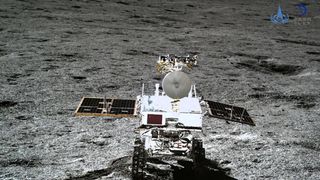China releases world's most detailed moon atlas (video)
The detailed atlas maps out lunar history and resources.
China has released a highly detailed geologic atlas of the moon.
The atlas, which is available in Chinese and English, depicts the surface of the moon with a scale of 1:2.5 million. It highlights many intriguing geological features, such as impact craters.
"The first thing that catches our eye are those rings, which we call the ring structure. In fact, each of these rings represents an impact event. The small ring is called an impact crater," Liu Jianzhong, a senior researcher at the Institute of Geochemistry, Chinese Academy of Sciences (IGCCAS), told China Central Television (CCTV).
"The big one right here is called an impact basin, which has a diameter of over 200 kilometers [125 miles]," Liu added. "Age groups are divided by colors. For example, the purple ones are the oldest impact craters."
Related: China to land astronauts on the moon by 2030, lunar scientist says

Chinese scientists and cartographers began drawing the map in 2012. China has launched a series of lunar probes, including Chang'e 1 and Chang'e 2, which were orbiters charged with mapping the lunar surface.
Further Chang'e missions have put landers and rovers on the near and far side of the moon (Chang'e 3 in 2013 and Chang'e 4 in 2019, respectively), while Chang'e 5 collected samples from the near side in 2020. China is preparing to launch its Chang'e 6 lunar far side sample return mission early in May.
Get the Space.com Newsletter
Breaking space news, the latest updates on rocket launches, skywatching events and more!
Ouyang Ziyuan, a senior and well-known Chinese lunar scientist, said that the atlas provides insight into the moon's history, its resource distribution and possible future exploration.
China plans to build a lunar base, known as the International Lunar Research Station (ILRS), in the 2030s. It aims to put its first astronauts on the moon before 2030.
Join our Space Forums to keep talking space on the latest missions, night sky and more! And if you have a news tip, correction or comment, let us know at: community@space.com.

Andrew is a freelance space journalist with a focus on reporting on China's rapidly growing space sector. He began writing for Space.com in 2019 and writes for SpaceNews, IEEE Spectrum, National Geographic, Sky & Telescope, New Scientist and others. Andrew first caught the space bug when, as a youngster, he saw Voyager images of other worlds in our solar system for the first time. Away from space, Andrew enjoys trail running in the forests of Finland. You can follow him on Twitter @AJ_FI.
